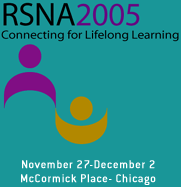
Abstract Archives of the RSNA, 2005
Roberta Agnes Jong MD, Presenter: Nothing to Disclose
Shalini S. Umranikar MD, Abstract Co-Author: Nothing to Disclose
Judith A. Wolfman MD, Abstract Co-Author: Nothing to Disclose
Robert Edward Hendrick PhD, Abstract Co-Author: Nothing to Disclose
Eric A. Berns PhD, Abstract Co-Author: Nothing to Disclose
Martin Joel Yaffe PhD, Abstract Co-Author: Nothing to Disclose
Petrina Ann Causer MD, Abstract Co-Author: Nothing to Disclose
Anat Kornecki MD, Abstract Co-Author: Nothing to Disclose
Nicole Brofman MD, Abstract Co-Author: Nothing to Disclose
Melissa Yip MD, Abstract Co-Author: Nothing to Disclose
Lewis I. Segal MD, Abstract Co-Author: Nothing to Disclose
Lora Duyan Barke DO, Abstract Co-Author: Nothing to Disclose
Mariam Thomas MD, Abstract Co-Author: Nothing to Disclose
Belinda Curpen, Abstract Co-Author: Nothing to Disclose
Ali Arshia, Abstract Co-Author: Nothing to Disclose
Ashwini Kshirsagar, Abstract Co-Author: Nothing to Disclose
et al, Abstract Co-Author: Nothing to Disclose
To evaluate the performance of CAD alone and of radiologists using CAD on a FFDM system
220 full field digital mammograms taken on the GE 2000D system were reviewed by 10 radiologists with varying experience in mammography prior to and then with CAD (R2 Technologies Image Checker, Version 8) assistance. The readers consisted of 1 resident, 4 fellows in breast or women’s imaging and 5 experienced breast imagers. There were 150 normal or benign examinations and 70 with biopsy proven cancer. There was at least a 1 year follow-up for normal cases and benign lesions. No prior mammographic examinations or clinical information was provided. Sensitivity and specificity of CAD alone was calculated. The sensitivity and specificity of the radiologists with and without CAD was determined. Correlation of the effect of CAD with varying radiologist experience was tested. For both the radiologists and the CAD, a true positive required correct identification of the location and type of lesion. Analysis was done to determine the relative performance for different lesion types and breast densities.
The sensitivity of experienced and trainee radiologists without CAD was 78.9% and 71% respectively. Using CAD, sensitivities improved to 80.3% and 74.3%. The specificity with CAD decreased only slightly more in the trainees (from 65.6% to 62.5%) than the experienced readers (from 73% to 72%). The sensitivity of CAD alone was better than any of the radiologists (94.3%) but specificity was considerably lower (39.3%). The sensitivity of CAD was not affected by breast density.
CAD performs well on the FFDM system. The benefit is greater for the less experienced reader and CAD sensitivity is unrelated to the amount of breast density.
A.K.: Ashwini Kshirsagar is an employee of R2 Technologies.M.J.Y.: Martin Yaffe's laboratory has a research collaboration on topics in digital mammography with GE Healthcare.
Jong, R,
Umranikar, S,
Wolfman, J,
Hendrick, R,
Berns, E,
Yaffe, M,
Causer, P,
Kornecki, A,
Brofman, N,
Yip, M,
Segal, L,
Barke, L,
Thomas, M,
Curpen, B,
Arshia, A,
Kshirsagar, A,
et al, ,
Performance of CAD on a FFDM System. Radiological Society of North America 2005 Scientific Assembly and Annual Meeting, November 27 - December 2, 2005 ,Chicago IL.
http://archive.rsna.org/2005/4408967.html

